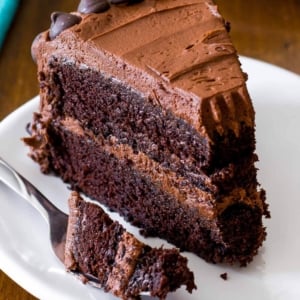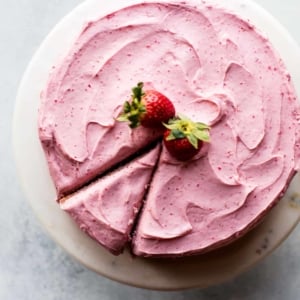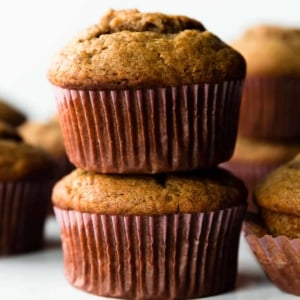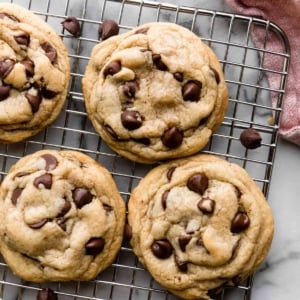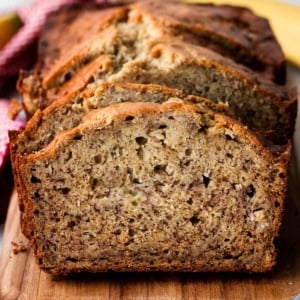Recipe FAQs
I don’t usually include nutrition information as it can vary between different brands of the same ingredients, and many recipes have ingredient substitutions or optional ingredients. However, there are many great online calculators where you can plug in your exact ingredients like this one.
Admittedly, my team and I do not have much experience using gluten free flour. Although some readers report using an all purpose 1:1 gluten free flour in many of our recipes with success, you should expect slightly different results. Here are all of our naturally gluten free recipes.
We wish we could help, but my team and I have no experience baking at high altitude. We know some readers have found this chart helpful!
While some recipes can withstand ingredient substitutions, most traditional baking recipes cannot. Remember that baking is a science and certain ingredients are used for a reason. If substitutions have been successfully tested, you’ll see it written in the blog post or recipe notes. Otherwise, we likely haven’t tested it. And when making substitutions, the results will always differ from the original recipe.
Some common substitutions we do use:
- Sour Cream/Yogurt: Typically, sour cream and plain yogurt can be used interchangeably in baking recipes.
- Buttermilk Substitution: If you don’t have any buttermilk, you can make a DIY soured milk. For every 1 cup of buttermilk, add 1 or 1 and 1/2 teaspoons of white vinegar or lemon juice to a liquid measuring cup. Fill with enough regular milk to yield 1 cup. Whisk together, then let sit for 5 minutes before using in the recipe. Whole milk is best, but you can use any fat or nondairy milk. The lower the fat, the less “rich” the baked good will taste.
- Cake Flour: When a recipe calls for cake flour, it’s best to use cake flour. In a pinch, however, you can make your own cake flour substitute.
Sugar is used for moisture and texture in baked goods as well as taste. You can certainly try reducing the sugar, but the resulting texture will be different than intended.
I have a page all about preventing dense or dry cakes if you want to review it. You’ll find a lot of information that will help you troubleshoot.
For help troubleshooting cookies that spread, visit 10 Guaranteed Tips to Prevent Cookies from Spreading.
When cookies aren’t spreading, it usually means that there’s too much dry ingredient (flour) soaking up all the liquid. Make sure you are properly measuring your flour. When measuring flour, use the spoon & level method. Do not scoop the flour out of the container/bag. Doing so leaves you with excess flour in the cookie dough. If you’re in the middle of baking a batch and the cookies still aren’t spreading, remove them from the oven, and use a spoon to slightly flatten them out before returning them to the oven. You can also take your big bowl of cookie dough and microwave it for 10 seconds to slightly warm it up before scooping/rolling/baking. Warm cookie dough spreads more. (This is what I do when I notice my cookies aren’t spreading!)
If my team and I have tested a different size pan it will be listed in the recipe notes. For any shapes/sizes that are not listed, you can use my handy Cake Pan Sizes & Conversions post to help calculate how much batter you would need for different size pans.
After decorating anything with buttercream or cream cheese frosting, it’s fine for 1 day at room temperature. After that, it’s best to refrigerate it. As always, use your best judgment and whatever you are comfortable with.
You don’t need to sift flour unless a recipe calls for it. If your recipe calls for 1 cup of sifted flour, sift the flour before measuring. If the recipe calls for one cup of flour, sifted– then you sift it after measuring. If the word “sifted” is listed before flour, you sift it before measuring. If the word “sifted” is listed after flour, sift it after measuring.
I know pie crust can be very difficult, so here are some tips that will help for next time:
- Here’s my tried and true pie crust recipe.
- Start with quality flour. We highly recommend King Arthur unbleached all-purpose flour.
- Make sure you are using very cold ingredients. You can even freeze your flour for 30 minutes before beginning.
- Keep the fats very cold– keep the shortening in the refrigerator before using and make sure your butter is cold, too.
- My team and I recommend using a pastry cutter to work the fats into the flour. A food processor can work for this step too, but we find it easily overworks the pie dough.
- Don’t over-mix the pie dough. After you add the water, lightly mix everything together. You want those visible specks and swirls of fat.
- If your pie crust requires pre-baking (blind baking), follow this helpful blind baking tutorial.
- Make sure you’re using enough liquid in your pie dough– most pie crust problems arise when there isn’t enough liquid in the dough.
My team and I test and write all of my recipes with a conventional oven. If you use convection settings (fan-forced) for baking, the general rule is to lower your temperature by 25°F. Additionally, keep in mind that due to increased airflow in convection ovens, recipes usually take less time to bake.
Blog FAQs
To receive new recipe updates, sign up for our general email list.
Yes! You can save any recipe from the recipe card, or click on the heart icon on the lower right-hand corner of the page. Then you can create an account, and find your saved favorites by clicking on the saved tag next to the heart, or click the magnifying glass at the upper right hand of the page.
Thank you for your interest in my cookbooks! You can purchase them in your local bookstore where cookbooks are sold or through online retailers including Amazon, Barnes & Noble, Book-a-Million, Indiebound, Powells, QuartoKnows, and Indigo-Chapters.
If you make and photograph one of my recipes, feel free to publish it on your website rewritten in your own words with credit given to the original recipe post on sallysbakingaddiction.com. Do not republish our recipe along with our photography unless we have negotiated compensation for our copyrighted work.
Thank you for your interest in using my copyrighted photography. You can share one of my copyrighted photos with its watermark as long as you give Sally McKenney credit with a link back to my website as the source. To use my photos for clip art/stock images, please email us for pricing and licensing details. Do not republish my recipe along with my photography unless we have negotiated compensation for the use of the copyrighted work.
You can find those details on my photography page.
No. Sally is the only author on this website.
Sometimes I mention our favorite baking products on this site, but we do not offer product reviews. We also do not accept free products in exchange for product reviews.
Contact
If you have a question about a specific recipe, please review the comments on that post. If your question hasn’t been answered, feel free to continue the conversation by leaving a comment or question directly in that post.*







